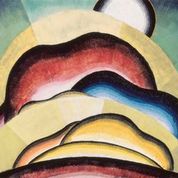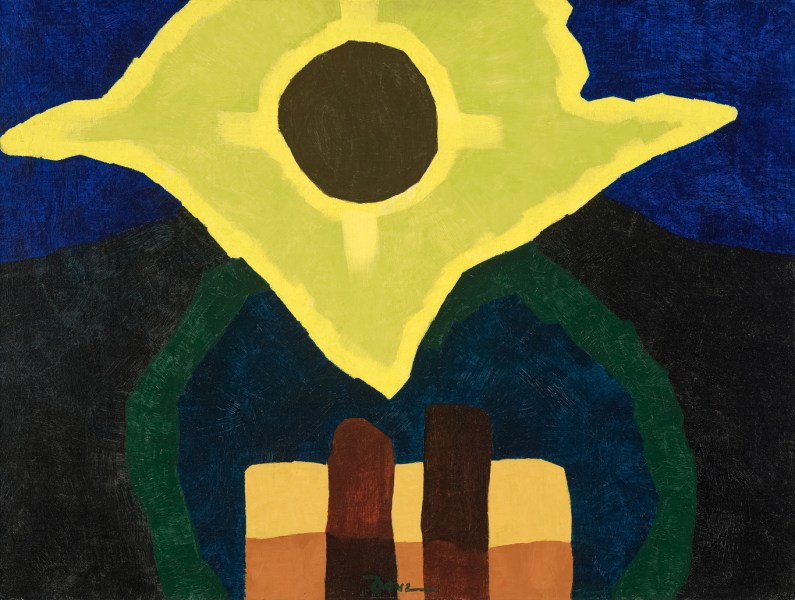
As writers began defining the vernacular aspects of American art in mid-1910s, the photographer and gallerist Alfred Stieglitz and his circle became a locus of attention. Two younger writers, Waldo Frank and Paul Rosenfeld, both neo-Freudians, were among those responsible for redirecting the interpretation of modernist expression. Frank and Rosenfeld became devoted to Stieglitz when both writers brought out The Seven Arts (1916-17), a short-lived publication that played an active role in the renewal of a native sensibility, an idea dormant since Walt Whitman. Later, in 1919, Frank wrote Our America, a manifesto that placed Stieglitz, along with Sherwood Anderson and Van Wyck Brooks, at the center of this resurgence. The book became a literary sensation, running through three editions in six months.
While Stieglitz closed his 291 gallery in 1917, he staged a series of shows at the Anderson Galleries in Manhattan in the early 1920s that reconsolidated his reputation as a trailblazing dealer. The critical bolstering of Frank and Rosenberg not only ensured his ongoing prominence but redounded on his artists. For, once Arthur Dove returned to painting full-time, the groundbreaking, inventive traits of his compositions became touted as uniquely American. Rosenfeld, in particular, projected sexualized rhetoric on his compositions by dwelling on their masculine characteristics. By the mid-1920s, when he published Port of New York, a collection of essays devoted to fourteen prescient Americans, he paired Dove with Georgia O’Keeffe in a metaphoric coupling, claiming, “Dove is very directly the man as Georgia O’Keeffe is the female.” In paintings such as Sunrise, with its heaving layers of clouds and luminous rings of light, he located a jubilance that was the match of O’Keeffe’s gendered images of flora. As Dove took in the vibrance of the natural world, he affirmed these priapic comparisons, writing to Stieglitz, “the bursting of a phallic symbol into white light may be the thing we all need.”

Beginning in 1930, Dove made a few trips back his to childhood home of Geneva, New York to visit his ailing mother. The trips were always arduous: his relationship with his family had remained conflicted since his father disinherited him in 1921. He had not been back to Geneva in more than two decades, but as his mother’s condition deteriorated, he made an exception. She had become empathetic about his vocation as an artist, and had collected his press reviews from exhibitions.
Dove’s trips north were taken aboard the Black Diamond Express, a train that carried him from New York through northern Pennsylvania to Broome County and eventually the Finger Lakes. He later described some of the scenery that he observed from the railroad car, noting to Stieglitz, “the green stream following the train.” Field of Grain as Seen From Train, presages this description, with its bold landscape curvature and striated field that skirt a rippling body of water or pond. The green furrows that recede and vanish suddenly at the skyline underscore that this composition was filtered through the intermediary of speed.
During the year he painted this work, Dove invoked the metaphor of locomotion to convey the progressive aspects of modern art in the title of a short essay, “THE 20TH CENTURY LIMITED, OR, THE TRAIN LEFT WITHOUT THEM.” While the train was hardly a new invention–its origins are tied to the early 1800s–he likened its motility to contemporary painting. The history of art was not a static venture, he intoned, but propelled through continuous elaboration of form that was bound to be disorienting to some. It had its correlates, moreover, in science, or the “time-space thing of the fourth dimension,” as he wrote, that were similarly predicated on the notion of a continuum. For Dove, these affinities centered around the “infinite,” or the limitless, never-ending, even cosmic sense of painting’s abstract possibilities.

Despite the ascendency of Regionalist painting during the mid-1930s, Dove’s annual exhibitions at Alfred Stieglitz’s An American Place gallery continued to generate considerable attention in the press. While he still struggled to sell his work, he did attract the critical limelight, earning his inclusion in manifold museum exhibitions nationally. Foremost among them were the biennial exhibitions of contemporary art inaugurated by the Whitney Museum of American Art in 1933.
By the time that Moon was exhibited in the Whitney’s 1936 installment of its much anticipated surveys, Elizabeth McCausland, who had emerged as a major proponent of artists’ associated with Stieglitz’s circle in the early 1930s, had lauded Dove as a “child of Nature,” someone who stood apart from the modernist pact for not “aping Picasso.” She elaborated that his work represented, “an epic drama…[and] fertility symbol.” Moon, with its columnar tree truck boldly lunging into the night sky, embodies McCausland’s quintessentially romantic view. Its phallic shaft literally climaxes in a sphere of radiating rings of white, grey and blue color that distill the intense luminosity of a lunar spectacle.
McCausland took her interpretative cues from Paul Rosenfeld’s earlier engendered interpretations of Dove’s painting, adding to it Freudian meanings. As Moon endured as one of Dove’s foremost pictorial statements, subsequent writers continued to build both on its sexualized references and its magical imagery. Frederick S. Wight, for example, who organized a posthumous retrospective of the artist’s work in 1958, effused over the painting’s “single erectile torch that makes night a territory of danger and joy.” His torrid account was later picked by the art historian Robert Rosenblum who read Dove’s cosmic sphere as not only one of his many “hymns to the pagan mysteries of the moon,” but a picture that presaged the work of Abstract Expressionists such as Adolph Gottlieb and Barnett Newman.

For one of Dove’s last exhibitions at Stieglitz’s An American Place gallery, Howard Devree, who wrote for the Sunday edition of the New York Times before becoming the newspaper’s art critic in 1947, noted in his brief review that the artist had “carried simplification of forms and arrangements about as far as possible.” By this juncture, Dove had pared his referents to a few essential shapes while honing a pictorial language that was simultaneously reductive and packed with meaning. In the process, he had landed in a new aesthetic realm that presaged the formal developments of a new generation known as the Abstract Expressionists. But where these artists ceased to engage imagery, Dove’s internationalization of nature still pervaded his compositions. High Noon, for example, with its hovering sun depicted at its zenith, remains a radical example of his ongoing preoccupation with the cosmos. This engagement with planetary themes, as well as with the landscape, would become part of his artistic legacy, after all.
When High Noon was exhibited in 1946, in New York shortly after Dove’s death, and as critics began to assess his achievement in retrospect, Thomas B. Hess–who would advocate for the originality of midcentury American art–claimed that Dove was distinguished from the New York School by his “idea… to remake abstraction after nature, and Nature was synonymous with God.” Had Dove located divinity in the great outdoors? Was there a spiritual dimension to his corpus of painting? Dove was an avid reader of religious and philosophical tracts that spanned the New Testament and theosophy to Vedanta, as well as the occult. But the arc of his reading was also counterbalanced by an interest in writers such as Nietzsche, who critiqued theology and Christian morality by promoting nihilism. If anything, Dove embraced pantheism, a holdover from the Enlightenment that gained popularity among the American transcendentalists. Just like Hess, Duncan Phillips, his primary patron, wrote after the artist’s death, “there was worship of the sun and moon. He looked right into a glow of morning sunlight… or into the face of the full moon.”
Adapted from Debra Bricker Balken, Arthur Dove, A Catalogue Raisonné of Paintings and Things.



 Fashion or Function?
Fashion or Function?